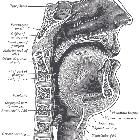Pharynx







The pharynx is the superior dilated part of the alimentary tract that connects the nasal and oral cavities to the esophagus.
Gross anatomy
It is composed of three parts:
- nasopharynx: posterior to the nasal choanae, extending from the vault of the pharynx superiorly to the soft palate inferiorly
- communicates with the nasal cavity anteriorly
- oropharynx: posterior to the base of tongue, inferior to the soft palate, bounded laterally by the palatoglossal and palatopharyngeal arches, and superior to the superior tip of the epiglottis
- communicates with the oral cavity anteriorly
- laryngopharynx (or hypopharynx): inferior to the superior border of the epiglottis and the pharyngoepiglottic folds, superior to the cricoid cartilage
- communicates with the larynx anteriorly
Musculature
The are two groups of muscles in the wall of the pharynx, the external circular layer and the internal longitudinal layer.
The external circular layer is composed of the three constrictor muscles:
The internal longitudinal layer is composed of the three paired muscles:
Innervation
The muscles of the pharynx are supplied by the pharyngeal plexus, a network of nerves from pharyngeal branches of the vagus and glossopharyngeal nerves.
Sensory innervation is primarily from the glossopharyngeal nerve with a few notable exceptions:
- the superior nasopharynx is supplied by the pharyngeal nerve of the maxillary division of the trigeminal nerve (V2)
- the valleculae are supplied by the internal laryngeal nerve (a branch of the vagus nerve)
- the rest of the laryngopharynx is supplied by the recurrent laryngeal nerve (a branch of the vagus nerve)
Blood supply
Numerous branches anastomose in the pharynx, providing it with a rich arterial supply:
- ascending pharyngeal artery (from the external carotid artery (ECA))
- ascending palatine artery (from the facial artery)
- lingual artery (from the ECA)
- tonsillar artery (from the facial artery)
- greater palatine artery (from the maxillary artery)
- artery of the pterygoid canal (from the maxillary artery)
- superior laryngeal artery (from the superior thyroid artery)
- inferior laryngeal artery (from the inferior thyroid artery, off the thyrocervical trunk)
Veins of the same name drain either into the pterygoid venous plexus or directly into the internal jugular vein.
Lymphatic drainage
Most lymph drains back to the retropharyngeal nodes.
Siehe auch:
und weiter:

 Assoziationen und Differentialdiagnosen zu Pharynx:
Assoziationen und Differentialdiagnosen zu Pharynx:

